 Back to selection
Back to selection
“Flying Blind”: Writer/Director Caleb Johnson On the Production, “SXSW Screening” and Future of His Feature The Carnivores
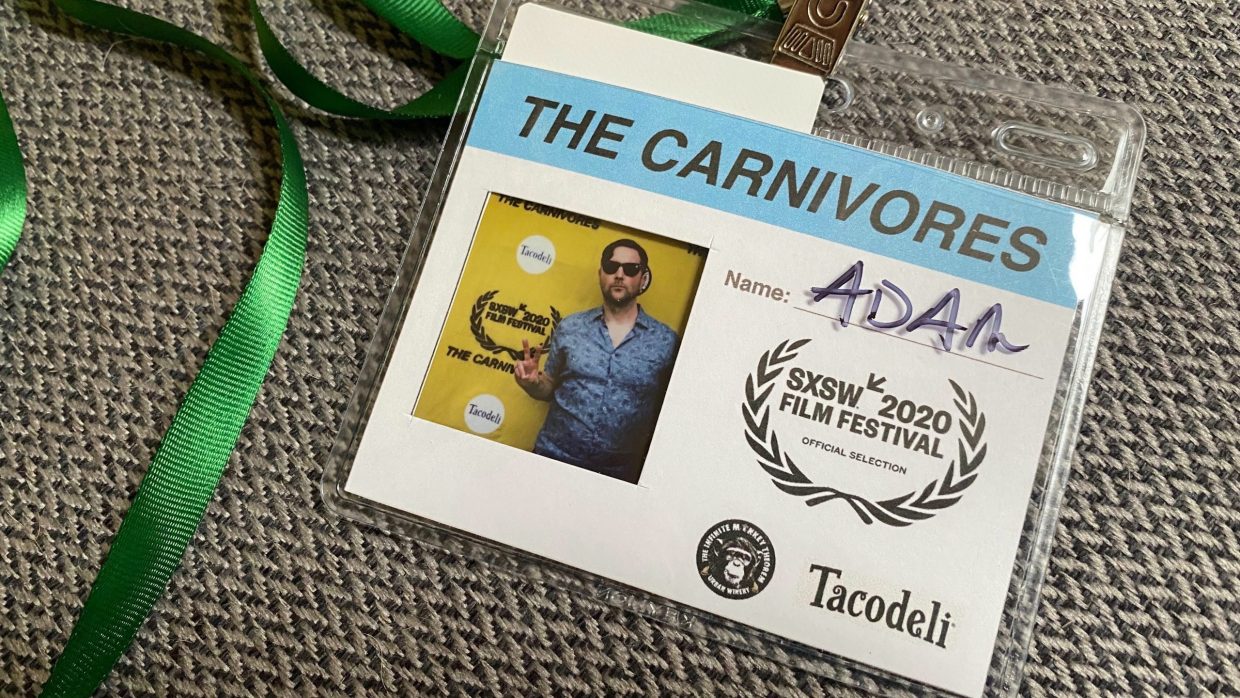 DP Adam Minick's "SXSW 2020" badge
DP Adam Minick's "SXSW 2020" badge In light of SXSW’s cancellation, a private “homespun” screening of the only local production in the festival’s narrative line up, Caleb Johnson’s The Carnivores, was arranged at its cinematographer’s (Adam J. Minnick) Austin residence on the night it was scheduled to premiere. The event hoped to encapsulate the spirit of the festival all at once. Upon entrance, invited press, programmers and audience got their photo taken on a polaroid against a classic yellow backdrop and laurels. That polaroid fit snug inside an imitation festival badge. After attendees stuffed themselves with Tacodeli they dragged over the red carpet to their seats and experienced a DCP of the film on a projection screen in lieu of the originally scheduled “Visions” section screening.
This was all planned before the local government numbers — limits on public gatherings — came in. Provisionally, they ranged from 200 to 250. The Carnivore team had invited 60 and expected less. But the coronavirus statistics were changing, and the filmmakers began to wonder if they’d invited people to something they wouldn’t be comfortable attending. (Soon after the event passed, gatherings over 50 were discouraged and eventually banned.) But as for that mid-March evening, some people cancelled, but a good number showed, and those who did witnessed something like the last nostalgic tribute to the festival and big-screen experience before all the theaters closed.

What follows now for The Carnivores is down time. Caleb Johnson, the film’s writer and director, plans to restrategize and resurface the film after the virus calms. This is a gap to hunker down and reconsider what’s familiar to Johnson, as he shot the film in two blocks a year apart. After shooting for nine days, he edited the initial footage for six months, rewrote the script to maximize on the strengths he discovered in that time and shot for another 11. This is a rare production model, perhaps only possible for something this homegrown and this “Austin,” one Johnson feels had advantages but that he’d never replicate.
The Carnivores is structured around a couple, Alice and Bret, and their infirm dog Harvey. For Alice, the vet bills have caused a financial spiral. For Bret, it’s all about Harvey — doing everything she can to help him. Alice feels neglected and the two haven’t been having sex, but Bret doesn’t seem inclined to notice so long as Harvey’s around. When Alice drags herself to a routine vet appointment, you know the kind of news she hopes to hear.
Filmmaker: How did the screening go?
Johnson: It was a good time. I think there was an initial scare because the state of the coronavirus was changing so fast. We had sent out an email the day prior as a reminder that was kind of our litmus test to see if people weren’t comfortable coming. We only got two cancels, and then an hour before the show several more started rolling in. But people did end up showing up. All of the effort that we put into it not being just a screening, all the little things, made it feel just out of the ordinary enough for it to be memorable and exotic. There were definitely moments when we wondered if we were just inviting people to this thing that no one felt comfortable coming to. And [those people] probably just didn’t come.
Filmmaker: Did the screening help shape the future of the film? Some SXSW films are attending later festivals.
Johnson: I don’t know, are they? [laughs] My only access to that stuff is to the other festivals we were supposed to play which have closed down or postponed — whatever that means. Pretty much anything through May or June is the line right now. I’m on this email thread with other people who are in the business category, and other people seem to be in the same boat. The only exceptions I’ve heard of are of films that were already sold, where that deal was already done, and the next stop was just whatever distribution was going to be. But it sounds like even some of those distributors are second guessing their plans. They stand to lose a lot of money on a lot of fronts, so I think they’re less eager to spend money anywhere until they have a better idea about what they’re up against.
My experience [with The Carnivores] is that all of the opportunities we anticipated have been thrown away or postponed, so I’m just assuming there’ll be this fairly expansive period of time when nothing happens and then we’ll start over with the festival stuff. Our screening was nice, but it was in a living room. We have yet to play the film in the way it was meant to be played on a big screen in 5:1. We did the DCP and QC’d it in a proper theater, just me, the colorist and Adam. I’m glad we did that just so I know how awesome it looks, but that cuts both ways because I know what we’re missing. Who knows, maybe I’m wrong, but I have a feeling there will be a time when this thing has a time to play.
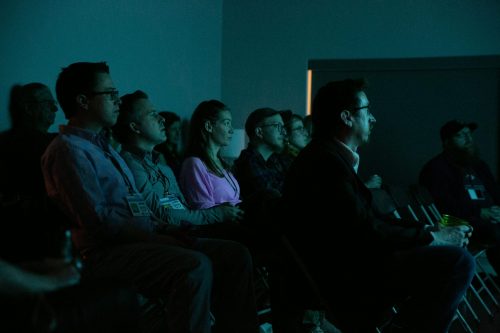 Filmmaker: What do you think about films that have opted to release VOD earlier than they might have in response to the situation? Is that a loss — or maybe them not maximizing on their film’s potential?
Filmmaker: What do you think about films that have opted to release VOD earlier than they might have in response to the situation? Is that a loss — or maybe them not maximizing on their film’s potential?
Johnson: It’s only a loss if you’re measuring against something that doesn’t exist right now. Of course fests and theaters will resume, but who knows when, and who knows what the landscape will be like at that point. I also think things are so disrupted right now that a VOD release now does not necessarily preclude a theatrical presence later. In fact, I’m sure there will be films that find/create a following via VOD that allows for a greater release down the road than would’ve been possible had nothing been turned upside down this year.
Filmmaker: Is there anything else you want to express that you feel about the unfortunate timing regarding the film, the festival, and the virus that you haven’t gotten the chance to — or that the discourse is forgetting?
Johnson: Much of the focus in the current upheaval has gone to the trajectory of the films themselves. But as much or more of the concern for me has been the relationships with other filmmakers that usually come with screening at SXSW and other fests that will now go unmade. At the indie level, so much of the arsenal to make a film comes from the contributions and guidance of people with whom you’ve formed a bond via previous work and screening together at fests. I will very much miss getting to know all those folks and their films with the kind of boiler-room intimacy that comes with premiering at SXSW.
Filmmaker: From what I understand, you essentially shot the film, reassessed the footage you had, and did reshoots later. How flexible was your production to enable that approach?
Johnson: We shot in two different blocks a year apart. Most of the stuff that got cut was things from the first year that we kind of planned on going in a certain direction and for whatever reason didn’t work in the way that we wanted. Or, more often than that, that we were excited about following up with a different angle. So there was some overlap. There was some duplication of ideas. We did a test screening last May, and, just because there were certain scenes that I loved but that I knew in my heart of hearts were redundant, I basically did a tight edit of the film for that work-in-progress screening and then at the end played the series of scenes that I loved. It was basically a test to see if people loved them as much as I did, and to see if they thought they could go somewhere. I think out of those five scenes that I tagged onto the end, one made it into the movie.
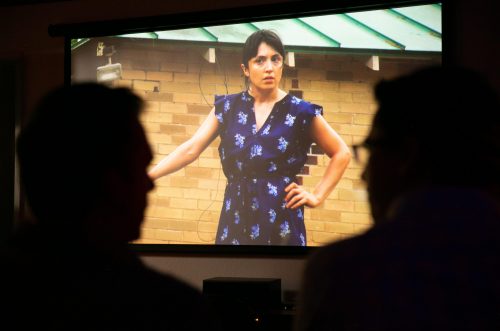
Filmmaker: Did you always intend to structure the production the way you did?
Johnson: We were a little naive. [The film] started out initially as something much more spontaneous and small. I think that we just had lower stakes, and we didn’t want to wait. We wanted to take advantage of the things that were available to us at the time. As soon as we got Lindsay on board, and her and Tallie in a room together, we got so excited about the possibilities. It suddenly became clear how much better it could be than [what we originally thought]. And so rather than saying, “We’re not prepared for this bigger thing, let’s stop and regroup in a year,” we said, “Let’s jump on what we have here” [in terms of time, availability and resources], and to see how far we can take it.
After that shoot I took the next six months to edit that footage. That was actually an extraordinarily productive way to work — I had time to write to maximize all of these things that were working. [Usually] at best you get an edit that’s happening during the shoot. You almost never have the chance to edit in this wide span of time and write more specifically. It was a huge risk, and I was fortunate that everyone was able to come back. I think there was a one person difference in the cast and crew between the two shoots. I would never do it again — at least not with a year in between. But it did occur to me that as a production method it could be coordinated in advance. It’s an extremely beneficial way to work — having a gap in the middle to regain some objectivity and account for what you have.
Filmmaker: Was it hard to get your producers/investors on board for something like that?
Johnson: [laughs] It was. Investor wise, this is something my wife and I had been saving for for a long time before, and so we were able to float most of what I wanted to do without anyone’s permission. That year in between did allow for us to save another chunk of money. At its largest our crew was maybe eight people, and because I was doing the editing myself no one had very much insight into the material. There was an anxiety about what we were gambling on, and for that reason, nobody ever flat out said, “No.” But I was aware of that and tried to be as grateful as I could about expressing my recognition and appreciation for them doing that—flying blind.
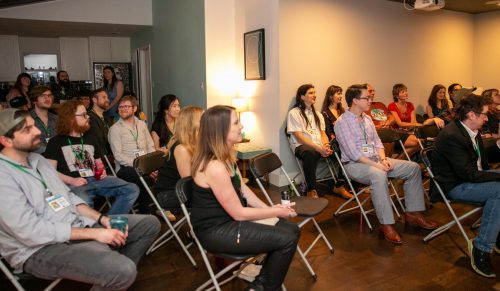 Filmmaker: In the film, a lot hinges on the balancing act of Bret’s (Lindsay Burdge) intense devotion to her dog. It’s never so much that our empathy for her gives out. Is that something you shaped/reshaped in your additional time with it?
Filmmaker: In the film, a lot hinges on the balancing act of Bret’s (Lindsay Burdge) intense devotion to her dog. It’s never so much that our empathy for her gives out. Is that something you shaped/reshaped in your additional time with it?
Johnson: I think Lindsay had a strong sense of where that balance should be from the beginning. The other half of that is that part of what we were interested in from the beginning was this divide: these two people are in this intimate relationship and yet they have such a distorted lens of each other. We were trying to play with that balance, how they saw each other, rather than how the audience was able to see those individuals subjectively. How much is this person’s problems perceived and how much of it is really part of the relationship?
A lot of this is structured in the writing. The film is divided in half between Tallie character’s, Alice, and Lindsay’s character, Bret. Alice is who we spend most of the first half with, and she’s the one who is kind of unraveling. Lindsay’s playing more of the straight edge. Then, it shifts focus when Lindsay joins Tallie and has a bit of an unraveling of her own. The centerpiece of that [dynamic] was always supposed to be the shower scene where they’re on either side of the glass — [there’s] a literal pane between them when they’re kissing. That [recurring] scene is divided into three parts throughout the film. In the beginning there’s the maximum amount of separation and by the end it would evolve to a point where that separation had been removed. I think that was in the treatment, even before there was a script, before there was casting, that was one of the core visual ideas Adam and I got excited about.
Something that also stuck was this aesthetic of being extremely low to the ground. You can see that especially, of course, when we’re on Tallie’s feet, whether she’s got the leash or she’s dragging the shovel. I think it was both to set them against the world at large and literally ground it. We didn’t want to go over the top with the bizarreness and fantasticality of a lot of the stuff that happens. So putting the camera at a grounded level was a way of making it clear that we weren’t leaving the realm of reality too much. I think it just so happened that Adam and I clicked because we share each other’s aesthetic so much visually.
Filmmaker: Did you always shoot two cameras for The Carnivores?
Johnson: No, but I think it was the majority of the time. If it was a dialogue scene we were shooting two cameras for sure, or if we were doing something like breaking a window — there were only four windows on that car [laughs] so it’d be hard to cheat it another way, so we captured that double. Eventually it became clear that there were places where it made sense and some places where the effort and coordination of the double cameras wasn’t worth the payoff.
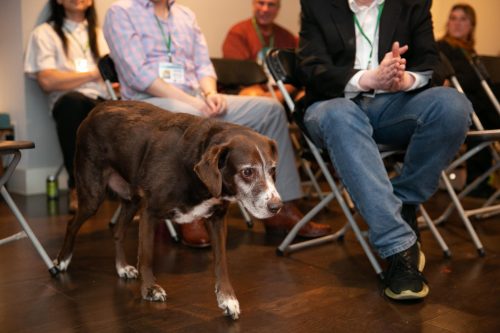
Filmmaker: As well as efficiency, it may lend something to its bifurcated structure?
Johnson: It’s both efficient in terms of how fast we needed to move and wanted to give actors the ability to deliver things the way they wanted. Or, to pick up a shred of Tallie we may not have expected or planned on. In that sense, just coverage wise and anticipating the edit, it allowed us to do that without having a script supervisor there to tell us to reproduce that same magic in another take. It was the only way we could think of to achieve the quality of shooting that we wanted in a fast-paced shooting and performance style.
Filmmaker: How was it working with Harvey (the movie’s dog)?
Johnson: He was a great dog. But he was, and still is, the production designer’s dog. He’s not a trained movie animal that we hired and could control very well. We had to go with what he wanted to do at any given moment.
Filmmaker: I’ve seen couples have to choose between their own financial situation and the health of their dog. Sometimes the decision has to be made at the expense of the dog’s health. It’s an unusual predicament. Did you experience/hear of a similar situation that inspired the central conflict of the film?
Johnson: I experience a version of that every time I go to the vet, it’s a bizarre exercise to pay for care that the animal almost certainly perceives as punishment. There’s always the question of whether we’re making choices for the animal or for ourselves—and most of what we put pets through is really for us at their expense. There’s an allegory there for romantic relationships, and that was my main interest. How much of what we love in the other person is really just a reflection we favor of ourselves? And how screwy do things get when that reflection shows us something ugly?
